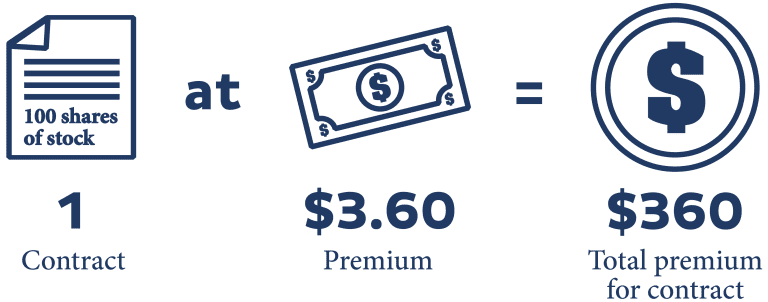There are times when an investor finds themselves with a single stock holding that makes up an uncomfortably large portion of their overall portfolio. Having a concentrated position is a double-edged sword; on the positive side you’ve accumulated some wealth, but the problem is that your fortunes are now unduly connected to a single company. You could of course sell the stock and diversify, but if the position is held in a non-retirement account there may be significant tax consequences to doing so. At times there may also be sentimental reasons for maintaining the position.
If you find yourself in that situation, you might consider using stock options to hedge your risk.
What is Hedging?
Hedging is a strategy that involves buying or selling security to reduce your risk of loss in another position. The hedge should appreciate in value if the position you are hedging decreases in value, thereby offsetting some or all of your losses.
Hedging can be thought of as an insurance policy in that it pays off in case of adverse outcomes. However, just like with an insurance policy, hedging has its costs. The cost of the hedge can vary depending on how much downside risk you want covered, and can sometimes even be free if constructed a certain way. You’ll also want to keep in mind that you may lose out on some potential appreciation of your underlying investments due to the hedge.
These costs and benefits should be weighed. Then, depending on your risk preferences, you can decide whether to hedge your investment and if so, to what degree.
While a variety of instruments can be used as a hedge, among the most common tools used as a hedge are options.
Options: A Quick Primer
An option contract gives the buyer the right, but not the obligation, to buy or sell an asset at a specific price, called the strike price, by a particular date, called the expiration date. For a stock option that would give the buyer the right to buy or sell the stock at the strike price by the expiration date. Some options can be exercised any time before the expiration date, while others can only be exercised on the expiration date.
There at two types of options. Call options give the buyer the right to buy the underlying stock at the strike price. Put options give the buyer the right to sell the underlying stock at the strike price.
The price you pay for a stock option is called the premium. The premium of an option depends on factors such as the current price of the stock, the strike price of the option, interest rates, the option’s time to expiration, stock dividends, and the expected volatility of the stock.
There are four main strategies to hedge your stock positions using options:
- Protective Puts
- Collars
- Put Spreads
- Covered Calls
Protective Puts
You can hedge your downside risk in a stock by buying put options. Owning a put gives the holder the right to sell their stock at the strike price of the option. This essentially acts as an insurance policy and puts a floor on the price of the investor’s stock over the life of the option. However, just like with any insurance policy, the investor pays a premium to receive downside protection.
Let’s look at a quick example.
Suppose you’ve owned 100 shares of Apple stock (AAPL) for several years at a cost basis of $80 per share, and the stock is now trading at $150. Let’s assume you would prefer not to sell the stock but are worried about the possibility of price declines in the next several months.
To hedge this position, you might consider a protective put. Each option contract represents 100 shares of stock, so you would buy 1 contract since you own 100 shares. Let’s say you choose to buy one contract of the $120 put that expires in 6 months for a premium of $3.60. The price you’d pay for this option would therefore be $3.60 *1 contract* 100 shares per contract = $360.

Paying this premium, you’d be insured against losses below $120 for the stock. However, you would still incur losses from the current price of $150 down to $120.
If AAPL stock decreases to $100 by the expiration of the option, then your option finishes “in-the-money”, you exercise it, and sell 100 shares of AAPL for $120 per share. If the stock finishes at $120 or higher by expiration, your $120 put expires worthless and you lose the premium you paid for the option of $360.
The long-put option hedge is the simplest, but also the most expensive type of hedge. Let’s look at another strategy that provides protection but can cost less to implement.
Collars
A collar is a strategy in which you sell a call and buy a put at the same time. The idea is that the put protects your downside, while the proceeds from the sale of the call pay for some (or all) of the price of that put.
While the benefit of a collar strategy is that it can be a near-costless hedge, there is also a downside. You have the risk your stock can be called away (sold) if the price moves above the strike price of the call you sell. Recall that when you sell one call option, you are obligated to sell 100 shares of the stock to the buyer of the call option if the stock trades above the call’s strike price on the expiration date. Therefore, you run the risk of having your stock position sold if it increases significantly in value, which could result in the realization of capital gains taxes.
Let’s look at an example of a scenario in which a collar hedging strategy might be something you’d consider.
Suppose you own 800 shares of Microsoft stock (MSFT) as a major holding in your portfolio. You’ve owned the stock for many years and don’t want to sell it because you think it will continue to increase over the long term. You’d also incur large capital gains taxes if you sold, and you prefer to defer those taxes for as long as possible. However, you’re concerned about the impact a large price decline could have on your overall financial health. You want to fully hedge this position, but you prefer to keep the hedge as inexpensive as possible. In this scenario, you could consider a collar strategy.
Let’s assume MSFT stock trades at $280 and you can buy the $200 put expiring in 12 months for a premium of $7.20. The $200 strike put option gives you protection for MSFT below $200. Instead of paying for the put premium out of your own cash, you sell a covered call at the $360 strike to fund the protective put purchase, receiving $7.00. You would buy and sell 8 contracts of each because you own 800 shares.
Your total cost would be: ($7.20-$7.00) *8 contracts* 100 shares per contract = $160

That $160 cost is relatively minor considering you are insuring nearly a quarter-million dollars worth of Microsoft stock.
Collars tend to be the most popular strategy for protecting the value of a portfolio or a large, concentrated stock position. However, it is important to keep in mind that your upside is capped if the stock rises above the call’s strike price. In this way, collars can limit both your losses and your gains.
Put Spreads
A put spread is simply a long and short put position. For example, with MSFT stock trading at $280, you can buy the $250 put and sell the $230 put. The sale of the $230 put partially offsets the cost of the $250 put. In this example, your stock position would only be hedged while the stock price falls from $250 to $230. If the stock price drops below the lower strike of $230, gains on the long put will be offset by losses on the short put.
A put spread can be a more inexpensive way to hedge your stock position than an outright long protective put. However, it also provides more limited downside protection.
Covered Calls
A covered call strategy consists of selling out-of-the-money call options against a long stock position. This strategy can be used to generate income if you believe the stock price will tend to move sideways. When you sell the call, if by expiration, the stock price is below the call strike, you get to keep the premium. Although this strategy doesn’t reduce downside risk, the premium you earn does help to mitigate potential losses to some extent.
However, this strategy does have a drawback. If by expiration, the stock price is above the strike price of the call option, you will be “assigned” on the call, and are obligated to sell stock at the strike price. If you don’t want to sell the stock and just want to earn the premium on the option sold, you can always buy back the option prior to the stock rallying to the strike price.
Let’s take an example.
Say you’re long 300 shares of Tesla (TSLA) stock and want to enter into a covered call strategy to generate additional income. Let’s assume TSLA stock is currently trading at $1,020 and that you don’t believe the stock will move very much higher or lower in the next six months. You decide to sell three $1,300 strike call option contracts (representing 300 shares) which expire in 6 months for a premium of $74.
You collect the following in premium: $74 *3* 100 = $22,200.

If by the expiration date, the price of TSLA stock is:
Below $1,300 – You keep the premium of $22,200 and still own 300 shares of TSLA.
Above $1,300 – You get assigned on the 3 calls you sold and are obligated to sell 300 TSLA shares at $1,300. You keep the option premium of $22,200 and you make gains on the stock price increase from $1,020 to $1,300. But you forfeit all gains above $1,300 on 300 shares of stock.
As with any hedge, selling covered call options has its positives and negatives. Generating income via selling option premium can be a profitable strategy especially if the stock doesn’t move very much in either direction. However, the downside risk still exists if the stock price declines and could outweigh any premium earned. The other consideration is how much upside you are willing to forfeit in case the stock moves sharply higher.
Conclusion
Hedging your concentrated stock positions using options can be a prudent risk management strategy to consider, though of course whether you choose to hedge will depend on your unique circumstances and objectives. If you do decide to hedge, make sure to carefully consider both the benefits and the costs of the four strategies outlined above. As with any “insurance,” hedging isn’t free, so you’ll want to make sure you’re comfortable with the potential costs prior to implementing a hedge.











